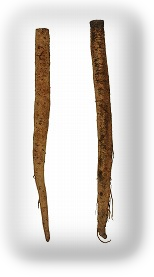
Burdock root is a very versatile vegetable. You can use it to make burdock root tea, take it in supplement form, or eat it as a vegetable. It has a pleasantly crunchy texture with an earthy and sweet flavor that is like celeriac or lotus root.
Burdock root belongs to the Asteraceae family and has the genus Arctium. It also is referred to by its plant name, Arctium lappa. The biennial plant is native to Europe and Northern Asia, but it now can be found throughout the U.S., where it grows as a weed. In Japan, it is grown as a vegetable and called gobo root. It is typically cooked or eaten fresh, while the young leaves can also be cooked like most vegetables.
The burdock plant has large, heart-shaped leaves and bright purple or pink-red, thistle-like flowers. The burdock roots are brownish-green or black on the outside. The slender root will typically grow over two feet tall.
Burdock Root Nutrition
What are burdock root nutrition facts? Burdock root contains primarily plant sterols, volatile oils, carbohydrates, tannins, and fatty oils. Studies have shown that burdock root contains powerful antioxidants, including quercetin, luteolin, and phenolic acids.
From a nutritional perspective, a cup of cooked burdock root contains 26.4 g of carbs, 2.6 g of protein, and 2.2 g of fiber. As for its micronutrient content, burdock root is an excellent source of vitamin B6, manganese, potassium, magnesium, and phosphorus. It also contains some vitamin C, vitamin E, vitamin K, vitamin B1, vitamin B2, vitamin B3, vitamin B5, folate, choline, betaine, calcium, iron, zinc, copper, and selenium.
Diabetes Treatment
Burdock contains the soluble and prebiotic fiber called inulin, which lowers blood sugar and improves digestion.
As a result, burdock root may be beneficial for managing blood sugar and treating diabetes.
In a rat study published in the journal Planta Medica in 2012, burdock root could reduce the severity of diabetic complications, including diabetic retinopathy.
Blood Purification?
Burdock root is described as a blood purifier in many traditional herbal texts, and it was believed to clear toxins from the bloodstream. The active ingredients in burdock root may detoxify heavy metals from the blood, which can improve organs over the entire body. It may also promote healthy blood circulation, which in turn improves skin health. More scientific evidence is needed to support this use, however.
Lymphatic System Detoxification
Alongside its touted natural blood cleansing properties, burdock root is said to have a powerful effect on the lymphatic system. The lymphatic system is the body’s drainage system, which is a network of lymph nodes and blood vessels that carry fluids from tissues around the body and into the blood. Burdock root is often used to induce detoxification and lymphatic drainage. Strengthening your lymphatic system can help the body fight all sorts of health issues. Still, more clinical research is needed to support this claim.
Diuretic Properties
Diuretics stimulate the kidneys and help rid the body of excess fluids. Burdock has also been used to help the body eliminate excess water and waste from the blood due to the increase of urine output.
Cancer-Fighting Properties
Burdock root shows promise in cancer treatment because it contains a lignin called arctigenin. Arctigenin has been shown to combat cancer cells by stopping the proliferation of cancer cells, and inhibiting cancer cells production of certain NPAT proteins.
Studies have found that arctigenin can kill human lung cancer cells, human stomach cancer cells, and human liver cancer cells. Animal studies have also found that burdock root can fight different types of cancers, including colon, mammary, and pancreatic cancer.
How to Use and Cook with Burdock Root
Fresh burdock root or dried burdock root is often found in Asian specialty stores, some farmer’s markets, and health food stores. Burdock root makes a great addition to stews or vegetable stir-fry. You can also pickle it, or peel, slice, and eat burdock root raw with some sea salt.
Always clean burdock root well; and if you don’t like the skin, you can peel it like a carrot. If kept in a cool and well-ventilated area, clean and dried roots can stay fresh for several months. Burdock supplements can be purchased in various forms either online or at a health food store. Supplement options include dried burdock root powder, burdock root capsules, burdock root tea, burdock root tincture, and burdock root oil. A typical dosage of powdered dry burdock root is one to two grams, three times daily.
Want some inspiration to make a burdock root recipe? Try the following burdock root and carrot stir-fry, which is also known as Kimpira.
Ingredients:
- 3 or 4 burdock roots, or about 4 cups cut into 2-inch pieces
- 1 carrot or a 1/2 cup of carrots, cut into 2-inch pieces
- 1 1/2 tbsp. of Asian-style sesame oil
- 2 tbsp. of coconut sugar
- 1/8 tsp. of shichimi togarashi or cayenne pepper
- 1/4 cup of soy sauce or coconut sauce
- Toasted white sesame seeds for garnish
Directions:
- Cut the burdock root and carrot into matchstick-sized pieces. Soak them in a large non-reactive bowl of cold water for about 20 minutes. Drain, and remove the excess water by wrapping the burdock root and carrot into a clean dishtowel, and remove as much water as possible.
- In a wok or large skillet, heat the sesame oil on medium-high heat, and stir-fry the burdock root and carrot for five to eight minutes.
- Add the coconut sugar, cayenne or shichimi togarashi, and mix well. Add the soy sauce or coconut sauce, and stir-fry until liquid is absorbed. Finally, sprinkle with sesame seeds before serving warm or at room temperature. You will get about four servings from the recipe.






